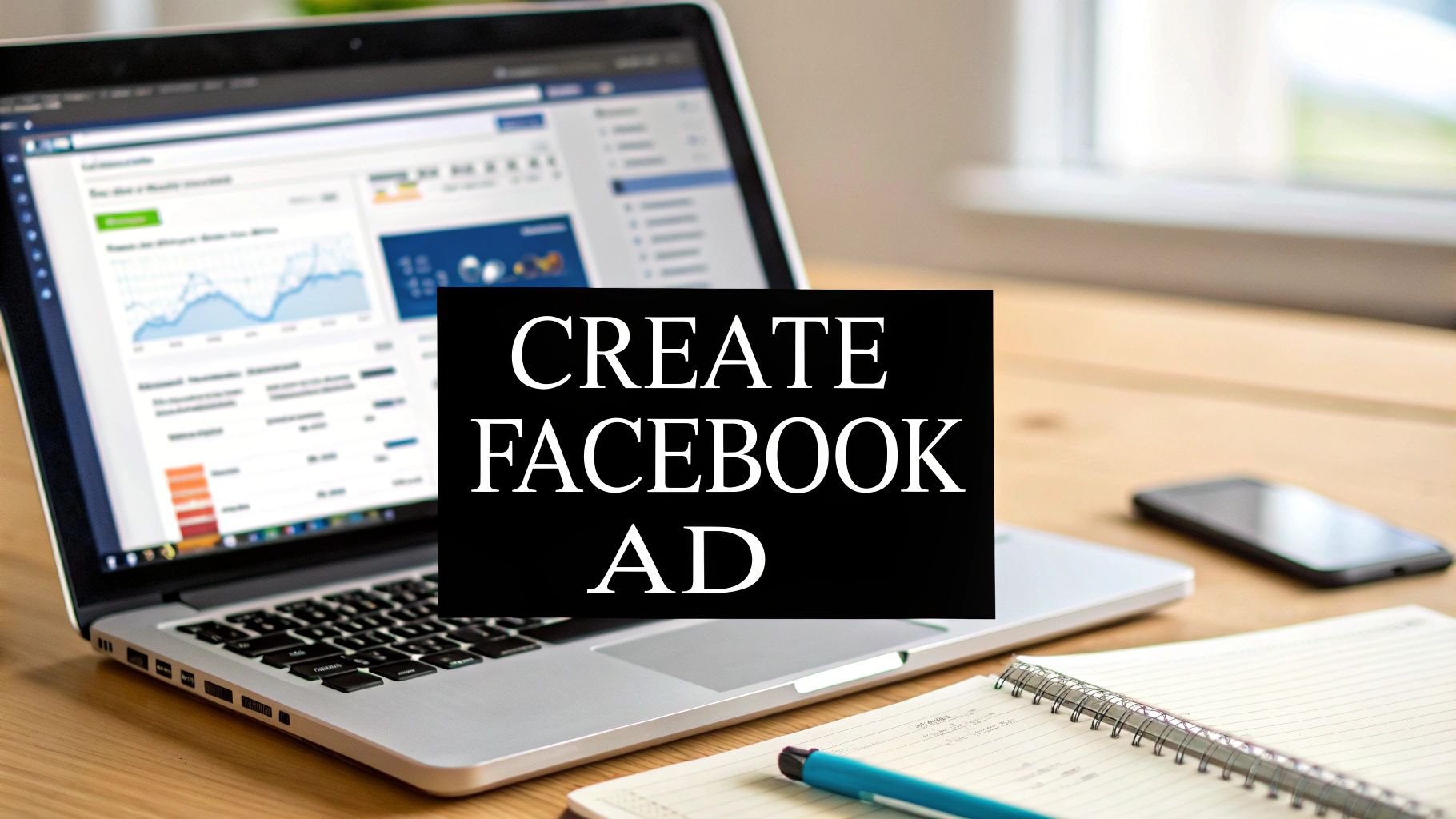
How to Create an Advertisement on Facebook
Learn how to create an advertisement on Facebook with this step-by-step guide. Master campaign setup, audience targeting, and creative design.
So, you're ready to create a Facebook ad. The actual process happens inside Facebook's Ads Manager, which walks you through everything from strategy to launch. It’s a powerful tool, but it's just that—a tool. Your real success depends on the prep work you do before you ever click "Create."
Laying the Groundwork for a Winning Facebook Ad
Jumping straight into Ads Manager without a clear plan is a recipe for wasted ad spend. Think of it like trying to build a house without a blueprint; you might get something standing, but it’s not going to be what you wanted. The real magic happens before you even open the dashboard.
This initial phase is all about defining what victory looks like for your business. Are you trying to boost sales for a new product line? Maybe you need to generate high-quality leads for your service business, or perhaps you're just focused on getting your brand name out there in a new market. Each of these goals demands a completely different strategy.
What You Absolutely Need Before You Start
Before you can even think about launching an ad, there are a couple of non-negotiables you have to get sorted. Nailing these fundamentals from the get-go will save you a world of technical headaches down the road.
- A Professional Facebook Business Page: This is the face of your brand on the platform. Your ads are tied to this page, so it needs to look professional and be actively managed.
- A Properly Set Up Business Manager Account: This is your command center. It’s where you’ll manage your ad accounts, pages, pixels, and all other advertising assets. Getting this right from day one is critical for smooth operations.
The potential here is massive. As of early 2025, Facebook ads could reach an estimated 2.28 billion users around the globe. That's about 27.9% of the world's entire population. The sheer scale means your ideal customer is almost certainly scrolling through their feed right now. You can dig deeper into Facebook's global reach on datareportal.com.
My two cents: The goal isn't just to run an ad. It's to achieve a tangible business result. Every single choice you make, from the image you pick to the audience you target, has to tie back to that core objective.
Getting these basics right isn't just busywork. You're building a solid foundation that will support all of your future campaigns. To get a head start on optimizing your efforts, it's worth exploring these essential Facebook advertising best practices. This prep work ensures every step that follows is far more effective.
Matching Your Campaign Objective to Your Business Goal
The very first choice you make inside Facebook Ads Manager—your campaign objective—is hands down the most critical decision you'll make for your entire campaign. This isn't just some administrative setting; you're literally telling Facebook's algorithm what success looks like. Get this right, and you're letting the platform do the heavy lifting for you.
Think of it like this: if you tell Facebook you want "Traffic," its algorithm will go out and find the cheapest clicks it can. It will find people who love to click but might never buy a thing. On the other hand, if you choose "Sales" (or "Conversions"), Facebook will hunt for users who have a history of pulling out their credit cards. The objective you choose dictates exactly who sees your ad.
For instance, a local coffee shop promoting a new seasonal latte would probably do well with an Awareness or Engagement campaign to build local buzz. But an e-commerce store dropping a new collection needs to go straight for Sales to drive revenue from day one. Choosing the wrong objective here is a surefire way to waste your budget.
From Jargon To Real-World Results
So, how do you translate Facebook's terminology into actual business outcomes? It's more straightforward than you might think. Facebook has simplified its objectives, but they all still roughly follow the classic marketing funnel.
Here's a quick breakdown of what to pick and when:
- Awareness: Perfect for getting your brand name out there. Use this when you're new, launching in a new area, or just want to stay top-of-mind. It's all about reach and impressions.
- Traffic, Engagement, App Promotion, Leads: This is your mid-funnel toolkit. Choose one of these when you want people to start interacting with you—clicking to your website, watching a video, sending a message, or filling out a simple form right on Facebook.
- Sales: This is the one that directly impacts your bottom line. You choose this when your goal is a specific, high-value action like a purchase or a detailed demo request on your website.
To make this crystal clear, here’s a table to help you map your business goals directly to the right Facebook objective.
Matching Your Business Goal to a Facebook Ad Objective
| Your Business Goal | Recommended Facebook Objective | Why It Works | | :--- | :--- | :--- | | "I want to get my brand in front of as many new, local people as possible." | Awareness | Optimizes for maximum reach and impressions within your target area, building brand recognition. | | "I need to drive more people to read my latest blog post." | Traffic | The algorithm will find users most likely to click a link and visit an external webpage. | | "I want more comments, shares, and likes on my posts." | Engagement | Prioritizes showing your ad to people who have a history of interacting with content. | | "I need to collect email addresses for my newsletter." | Leads | Uses Facebook's native lead forms, making it incredibly easy for users to submit their info without leaving the app. | | "I need to sell my products online." | Sales | Focuses on finding users who are most likely to complete a purchase or another valuable conversion event you've defined. |
Picking the right objective from the start is the difference between a campaign that feels like it’s printing money and one that’s just burning through your budget.
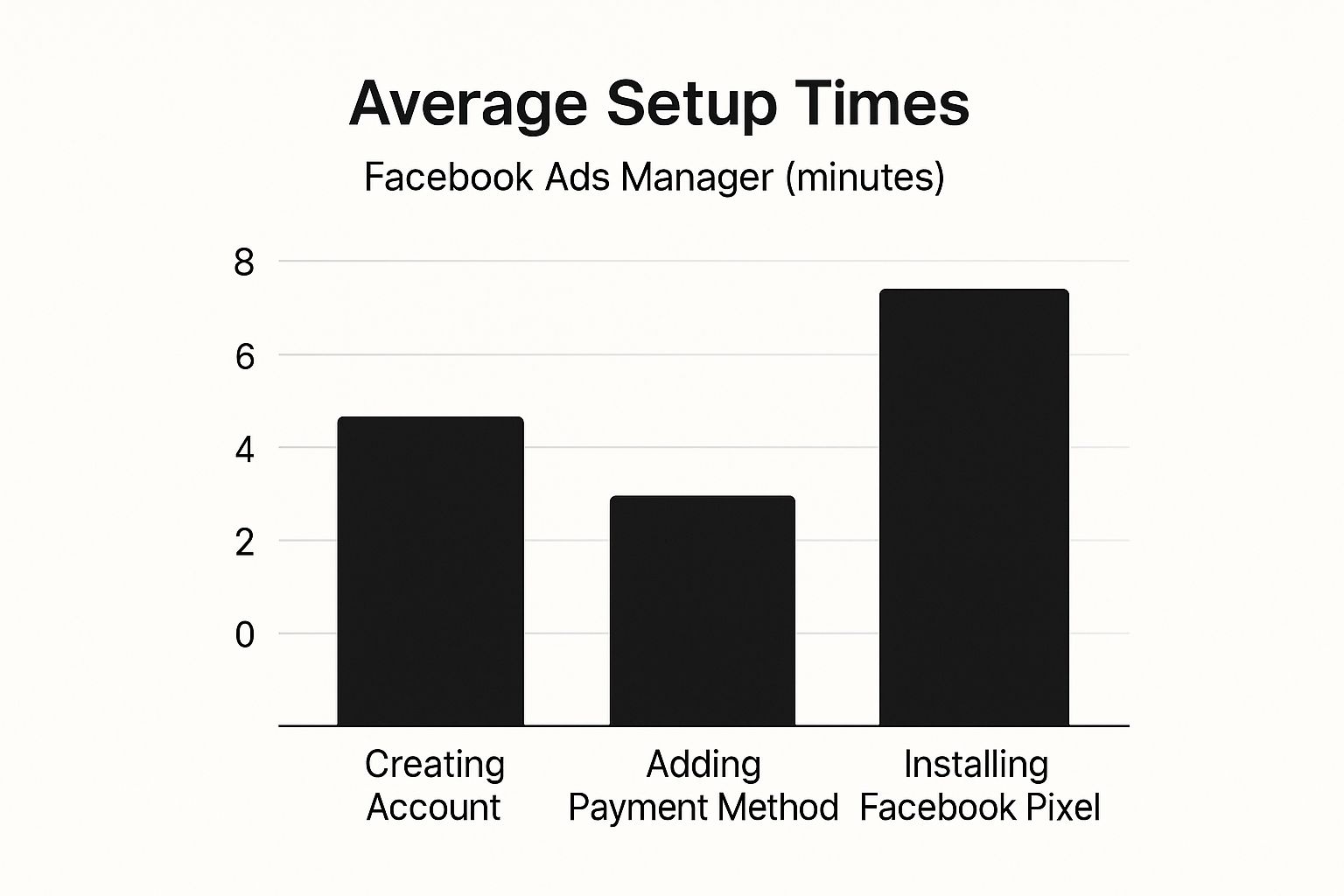
The data backs this up. A deep dive into Facebook ad statistics shows that advertisers are heavily focused on driving direct results. About 27% of all Facebook ads are optimized for conversions, making it the most popular objective for those chasing measurable revenue. Other goals like post engagement (24.2%) and link clicks (22.6%) are also common, showing that savvy marketers use a mix of strategies to move customers through their funnel.
My Two Cents: Don't just pick the objective that sounds closest to your goal. Be brutally honest about the single most important action you want someone to take. If that's a sale, choose Sales, even if it seems more expensive at first. You're paying for results, not just clicks.
Finding and Targeting Your Ideal Customer
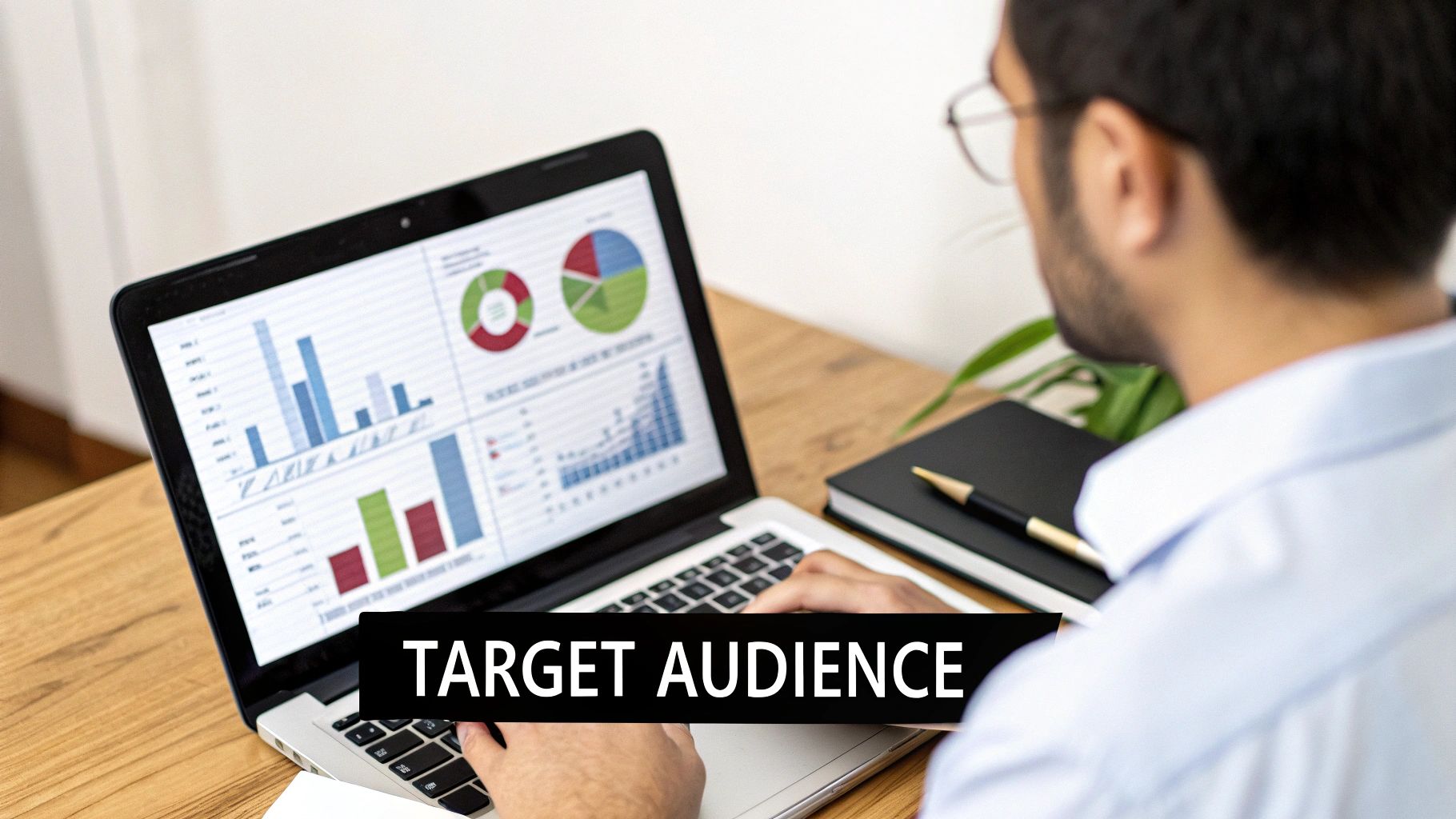
Let's be clear: the most beautiful, compelling ad in the world is a complete waste of money if it doesn't reach the right people. This is where your Facebook ad strategy really starts to pay off. The goal isn't just to get more eyeballs on your ads; it’s about getting the right eyeballs.
This is exactly where Facebook's advertising platform shines. It gives you an incredible set of tools to zero in on your ideal customer with surgical precision.
You’re essentially building your audience from scratch, starting with broad demographics and layering on specific interests and behaviors. Think of it less like throwing a wide net and more like crafting a specific key for a very specific lock. It's so important to master Facebook Ads targeting options right from the start. Getting this wrong means you either burn cash on an audience that’s too broad or miss out on sales because you've gone too narrow.
The Three Pillars of Audience Targeting
Facebook breaks down its targeting into three core categories. I’ve found that the most successful campaigns eventually use a mix of all three.
-
Core Audiences: This is your foundation. You define this audience manually based on criteria like age, location, gender, and—most importantly—their interests and behaviors. Are they into "digital marketing" or "yoga"? What are their online purchasing habits? This is where you start.
-
Custom Audiences: Now we get powerful. This targeting option uses your own data. You can upload your customer email list, retarget people who visited your website (using the Meta Pixel), or even create an audience of users who watched a certain percentage of your video ad. It's a goldmine for reconnecting with warm leads.
-
Lookalike Audiences: This is where the magic happens. Once you have a strong Custom Audience—say, a list of your most valuable customers—you can tell Facebook to go find millions of other people who share similar traits. It's one of the most effective ways to scale your campaigns and find new customers who look just like your best ones.
Your targeting is only as good as the data behind it. Don’t guess who your customers are. Take the time to build detailed buyer personas. Knowing your audience inside and out will guide every single choice you make in Ads Manager. Read more here to create your own: https://viewprinter.tech/blog/articles/how-to-create-buyer-personas
Here’s a real-world example. Imagine you're running ads for a local yoga studio. You could start with a Core Audience targeting women aged 25-45 within a 10-mile radius who have shown an interest in "yoga," "mindfulness," and "Lululemon."
After running that for a bit, you could then create a Custom Audience to retarget everyone who visited your "Class Schedule" page but didn't sign up.
Finally, you could take your list of current members, upload it, and create a 1% Lookalike Audience to find brand new people in your area who are highly similar to your existing clientele. This layered approach is what separates the pros from the amateurs.
Managing Your Ad Budget and Schedule
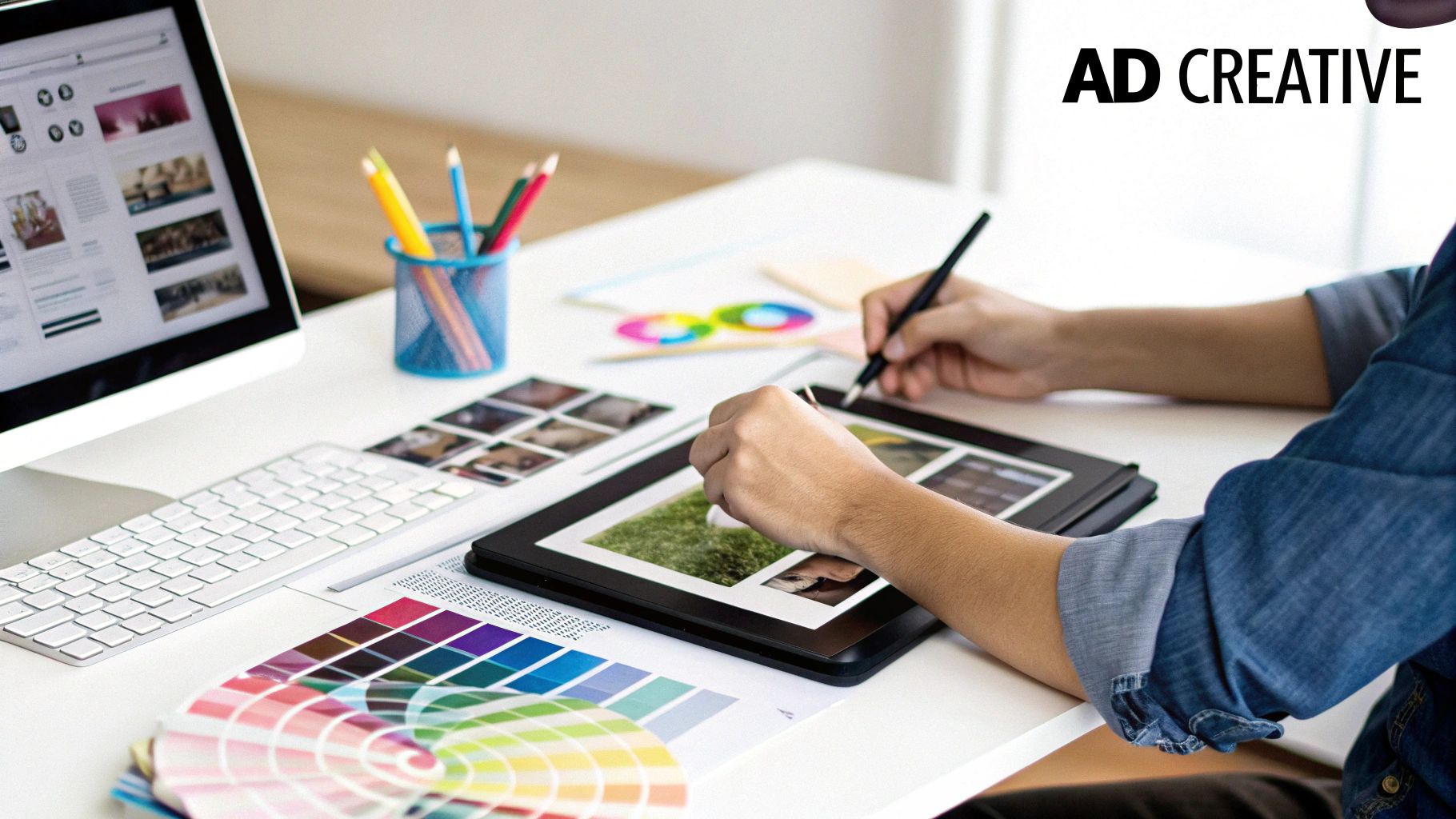
Let's talk about the money. Smart budget management is often what separates a profitable campaign from a costly mistake. How you allocate your spend tells Facebook's algorithm how aggressively to chase your goals, and it has a massive impact on your return on investment.
Your first big decision here is whether to go with a Daily Budget or a Lifetime Budget. Think of a daily budget as your steady, consistent spend—perfect for evergreen campaigns that are always running. You tell Facebook how much to spend each day, and it sticks to that number.
A lifetime budget, on the other hand, is built for campaigns with a clear start and end date, like a weekend flash sale or a month-long promotion. You give Facebook a total amount to spend over the entire period, and it will automatically adjust the daily spend to capitalize on the best opportunities. Some days it might spend more, others less, all in the service of getting you the best results.
Daily vs. Lifetime Budgets
| Budget Type | Best For | Key Advantage | | :--- | :--- | :--- | | Daily Budget | Ongoing, always-on campaigns. | Provides consistent daily ad spend and delivery. | | Lifetime Budget | Fixed-duration campaigns (e.g., sales, events). | Allows for flexible daily spending to maximize results over the campaign's flight. |
If you opt for a lifetime budget, you unlock a handy feature: ad scheduling. This lets you control the exact days and hours your ads are shown. For example, if you're a restaurant promoting a lunch special, you could set your ads to run only from 10 AM to 2 PM on weekdays. Why spend money showing ads when your customers aren't in a buying mindset?
One of the most common rookie mistakes I see is setting a budget that's way too small for the audience size. If you're targeting millions of people with a $5 daily budget, the algorithm never gets enough data to learn and optimize. Your campaign will almost certainly fizzle out.
Remember, Facebook runs on an ad auction. Your bid, ad quality, and relevance all play a role in who sees your ad and when. While the average cost-per-click (CPC) across all industries hovers around $1.05, this can swing wildly depending on your niche. For perspective, every $10 spent can get your ad in front of an average of 2,417 users. You can dive deeper into these numbers with these Facebook ad costs and reach efficiency stats.
Ultimately, a well-defined budget is a cornerstone of any good marketing campaign planning template, ensuring every dollar is working as hard as it can for you.
Crafting Ad Creatives That Stop the Scroll
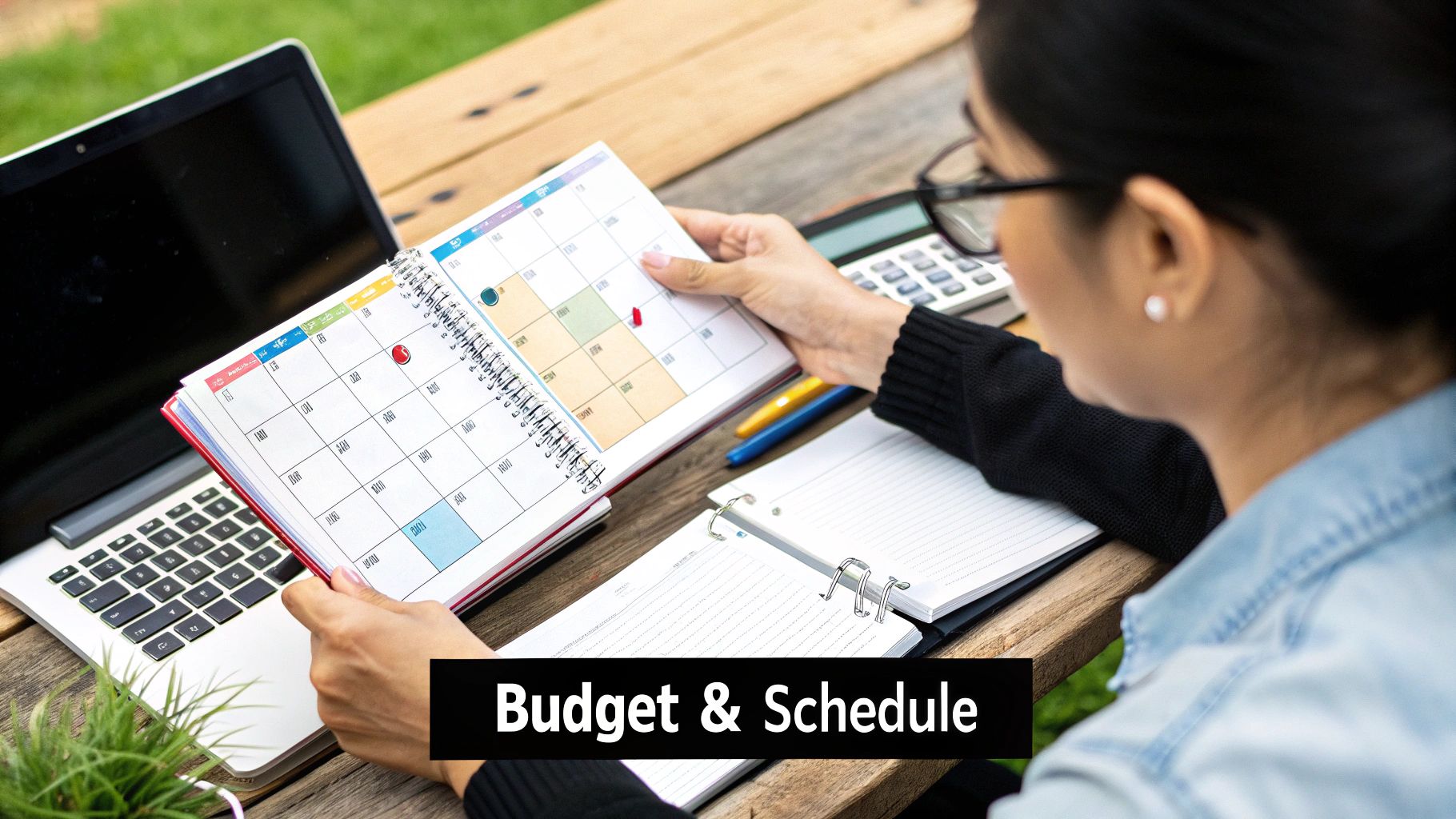
Let's be honest, your ad is an interruption. It shows up in a sea of baby photos, vacation updates, and memes. To have any chance of success, your creative has to break through that noise and stop someone's thumb mid-scroll.
No amount of brilliant audience targeting can save a boring ad. Your creative—the visual and the text working together—is your only shot to make someone pause and pay attention. The best ads feel like they belong in the feed, but they have a hook that's impossible to ignore.
This all starts with a powerful visual. Think of a stunning photo or, even better, a short, punchy video. It's no secret why video is king; a staggering 73% of consumers say they'd rather watch a short video to learn about a product.
Once you have their eyes, the ad copy needs to seal the deal, and fast. That first line is everything. It has to hit on a real pain point or a deep desire your audience feels.
Choosing the Right Ad Format
Facebook gives you a whole toolbox of ad formats, and each one is built for a different job. The biggest mistake I see is people defaulting to a single image ad just because it's the quickest to set up. You have to match the format to your goal.
- Single Image/Video Ads: These are the bread and butter of Facebook ads. They're perfect for delivering one clear, powerful message.
- Carousel Ads: An e-commerce favorite for a reason. You can show off several products, zoom in on different features of a single item, or even walk someone through a process.
- Collection Ads: This is a mobile-only powerhouse. Tapping the ad opens up a full-screen, instant storefront where people can browse products. It's fantastic for turning interest into sales right from the feed.
Video is where the real engagement happens. If you're serious about grabbing and holding attention, take a look at our guide on https://viewprinter.tech/blog/articles/how-to-create-video-ads for some expert tips.
My Two Cents: If you only focus on two pieces of text, make them your headline and your Call-to-Action (CTA). A great headline makes a bold promise ("The Last Backpack You'll Ever Need"). A great CTA tells them exactly what to do next with a sense of urgency ("Shop Now & Get 20% Off").
At the end of the day, there's no magic formula. The only way to find out what works is to test. Run different formats, try out a few copy angles, and see what your audience actually responds to. Then, put your budget behind the winners.
Got Questions About Facebook Ads? We've Got Answers.
Diving into Facebook ads always sparks a few questions, especially if you're new to the game. It’s completely normal. Getting a handle on these common sticking points early on can save you a ton of headache (and budget) down the road.
Let's clear up some of the things new advertisers ask the most.
How Long Should I Run a Facebook Ad?
Patience is key here. I always recommend letting a new campaign run for at least 3-5 days before you even think about making any big changes.
Why? Because Facebook's algorithm needs time to work its magic. This initial period is called the "learning phase," where the system is actively figuring out who to show your ad to for the best results. Performance will be a bit erratic at first, but after a few days, it stabilizes. Only then will you have reliable data to decide what's working and what isn't.
What's the Difference Between Boosting a Post and Creating an Ad?
This is a classic one. Boosting a post is essentially advertising on easy mode—it’s great for getting more eyeballs and engagement on something you’ve already posted. But that's where its utility ends.
Creating a proper ad in Ads Manager is where the real power is.
Think of it this way: Boosting is like using a megaphone, while Ads Manager is like having a full-blown marketing control center. It unlocks everything you need for serious results—sales objectives, lead generation, super-detailed audience targeting, and analytics that actually tell you what’s driving your ROI.
Why Was My Facebook Ad Rejected?
It happens to the best of us. If your ad gets rejected, it’s almost always because it tripped one of Facebook's Advertising Policies.
Some of the most common culprits I see are:
- Making bold claims you can't back up (e.g., "Lose 30 pounds in 30 days!")
- Using images that are more than 20% text
- Trying to advertise something on their prohibited list
- Targeting audiences in a way that could be considered discriminatory
Don't panic. Facebook will tell you why it was rejected. Just read their feedback, check the official policy page, and tweak your ad before you submit it again.
Ready to create scroll-stopping video ads without the hassle? With ViewPrinter, you can use AI to build dynamic slideshows, generate high-converting UGC-style ads with custom avatars, and automate your content schedule across social media. Start creating ads that get results today at https://viewprinter.tech.